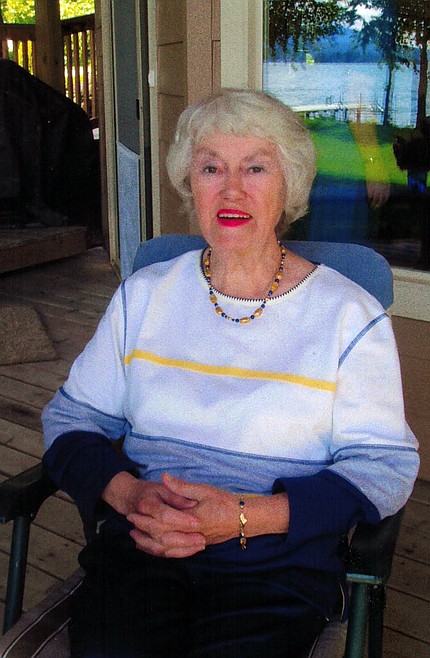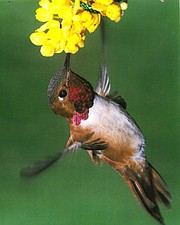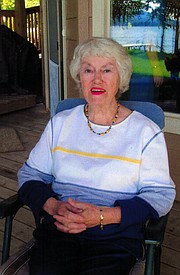Feathered friends, flowers and fragrance
Sometimes, when things seem dark and worrisome, Mother Nature sends a golden moment that banishes fears and heals hearts with a snap of her fingers. As this very morning when I stepped out onto the deck worrying over family problems –and happened to glance at the newly cleaned and filled birdbath. At that very instant, a brilliant beam of the morning sun focused on it and, like a performer in the spotlight, a magnificent Piliated woodpecker flew to its edge to drink! His brilliant red crest glowed in the sun like a jewel and I stood in awe and watched him quench his thirst – all my dark thoughts vanished. What a gift!
Birds have been special to me all my life, but since I moved to this house over 20 years ago they are now a constant factor. I know for a fact that the same pair of Towhees has spent their spring/summers here for at least 15 years, raising just one hatchling each year (that I know of). Too, from the beginning there has always been a small flock - 25 or so – of Juncos. They are so dear and unobtrusive, running across the ground like little chickens, friendly to all the other birds but still keeping to themselves. There are changes, too. Where the first five years here saw a healthy flock of Rosy and other red-purple finches, one spring they just didn’t show up and I’ve never seen another since. “Newlings,” though, make up the balance – the Pine Siskins, for instance – which first came in droves about two years ago, are just now returning – along with the swallows. Daughter Diane gets the best of the swallows, however, in her more open surroundings. And let us not forget the turkeys: Thankfully, it’s about time for them to “head for the hills” for the season to mate, lay eggs, hatch and raise their babies. I’ll welcome the interim – My most recent count at feeding time was over 100! That’s a lot of sunflower seeds and a lot of turkey poop. I love ‘em but won’t miss the respite!
I’m still awaiting the hummingbirds – their nectar bottle is filled and hanging at the ready. Generally the tough little Rufous come first – they stake their claim and fiercely battle later comers like the Allens and Annas. I was so happy to read the information passed on by true bird expert Mike Turnlund, whose recent column in “Neighbors” pointed out that early arriving hummingbirds sipped tree sap until nectar-holding flowers came into bloom. With my plethora of huge – very sappy – Cottonwoods, it negates my concerns for the tiny creatures’ survival.
In case you would like to use hummingbird feeders and are new to it, here’s how. Bring 4 cups of fresh cold tap water to a boil, add 1 cup of pure granulated sugar (I use C&H Cane sugar rather than beet or corn sugar, but it probably doesn’t matter – just so it’s plain white granulated sugar).* Let it boil a minute or so till completely dissolved, remove from heat to cool and refrigerate till time to put into the feeder. No color is necessary – most feeders have red on them as an attractant anyhow. If you’ve considered buying pre-made or nectar mix– please think again. I took the time to read the ingredients and was aghast! There were about 17 listed, beginning with distilled water, fructose, sucrose – and on and on from there including artificial red food coloring (bad enough for humans let alone tiny hummingbirds) and three added vitamins – plus some added minerals. If you are reading this, and have used purchased nectar, please reconsider and make your own.
*Consider if someone decided to use, say, Splenda, instead of granulated sugar, it would doubtless ultimately prove fatal to the tiny hummingbird, since it contains aspartame, as does Nutrasweet, Sweet and Low, and a host of other artificial sweeteners, all to be avoided at all costs. Honey, by the way, while natural and healthful for most humans, is a no-no in nectar for hummingbirds! It lacks what they need in nutrition, and while they may drink it, they will literally starve to death on it! So stick with the simple and healthy and enjoy the show!
Of course, hummers and other birds as well as bees and butterflies, are drawn to the color and fragrance of flowers when they finally bloom, and it’s such fun to walk through the yard and see the various nectar-drinkers and pollen-gatherers at work on the various blooming flora. Like color, fragrance too draws certain fanciers – and when I saw today’s illustration in an old garden magazine I had to feature it. What’s more fragrant than Sweet peas? So hardy, so lavish, so rewarding, it’s strange that more people don’t plant them as ornamental porch screens or fence climbers. They are a panacea for pollinators, food for nectar sippers and heavenly scent in the landscape and bouquets for the housebound.
Speaking of flowers, I just took a stroll down the flagstone garden path to see what’s happening. In my cold area in Schweitzer’s shadow, things come up later than in town but multitudinous tiny flecks of greenery show me the wild violets are on their way. I simply love them and look forward to their purple clusters that announce Spring’s true arrival. The mini-daffodils are poking through, as are the native Idaho Iris spears. Last year, I transplanted some Wooly Lamb’s Ears into the big half-wine barrel that hosts the Clematis, and the furry, pettable leaves are just appearing. So far, so good – soon the native Pulmonaria – Lungwort, with the spotted leaves resembling their name – will join the numerous ferns which also seem to have weathered the winter well.
I’ve tidied things up a bit and returned my landscape ornaments to their seasonal sites: St. Fiacre and the Fairy and Frog are once again on the lookout. Soon, our short but sweet season will burst forth with everything that makes life in north Idaho worthwhile. Enjoy!
Valle Novak writes the Country Chef and Weekend Gardener columns for the Daily Bee. She can be reached at bcdailybee@bonnercountydailybee.com. or by phone at 208-265-4688 between the hours of 8 a.m. to 7 p.m.





